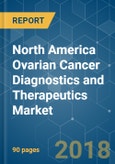The North America ovarian cancer diagnostics and therapeutics market is expected to register a CAGR of 12.5% during the forecast period, 2018 to 2023. The United States is expected to dominate the market for ovarian cancer diagnostics and therapeutics due to the increasing incidence of ovarian cancer.
Increasing Population of Aged Women
The risk of ovarian cancer increases in women in the age bracket of 55-64 years. According to the US Census Bureau, women above 60 years of age accounted for almost 57% of all ovarian cancer incidences and 75% of all ovarian cancer related deaths worldwide, with median age at diagnosis being 63 years and median age at death being 70 years. Thus, the increasing population of aged women is driving the growth of the North American ovarian cancer diagnostics and therapeutics market.
In addition, the increasing incidence of ovarian cancer worldwide and greater use of combination therapies for the treatment of ovarian cancer are fueling the growth of the
North American ovarian cancer diagnostics and therapeutics market.
Lack of Accurate Diagnosis of Ovarian Cancer
Accurate diagnosis for ovarian cancer is critical, as in most cases, the cancer already begins to spread to the lymph nodes and outside of the pelvis at the time of diagnosis. Ovariancancerawareness.org reports that the five-year survival rate for ovarian cancer with early stage 1 detection is 93%, and that most new cases of ovarian cancer are diagnosed at stage 3 or later, leaving little time as well as room for an accurate diagnosis. Lack of early detection and accurate diagnosis is often because ovarian cancer symptoms are frequently overlooked, and easily confused with other conditions. In addition, patent expiry of key drugs is also restraining the growth of the market.
United States to Dominate the Market
The United States is dominating the market due to increasing incidence of ovarian cancer. As per the American Cancer Society, it was estimated that 22,280 new cases of ovarian cancer would be diagnosed in 2017, whereas in 2016, an estimated 20,000 patients were diagnosed with ovarian cancer in the United States alone.
Key Developments in the Market
The major players include - Bristol Myers Squibb Company, Eli Lilly and Company, GlaxosmithklinePlc, Janssen Pharmaceuticals, Inc., Genentech Inc., Astra Zeneca Boehringer Ingelheim, and F. Hoffman-La Roche Ltd, among others.
Reasons to Purchase the Report
Customization of the Report
This report can be customized to meet your requirements.
This product will be delivered within 2 business days.
Increasing Population of Aged Women
The risk of ovarian cancer increases in women in the age bracket of 55-64 years. According to the US Census Bureau, women above 60 years of age accounted for almost 57% of all ovarian cancer incidences and 75% of all ovarian cancer related deaths worldwide, with median age at diagnosis being 63 years and median age at death being 70 years. Thus, the increasing population of aged women is driving the growth of the North American ovarian cancer diagnostics and therapeutics market.
In addition, the increasing incidence of ovarian cancer worldwide and greater use of combination therapies for the treatment of ovarian cancer are fueling the growth of the
North American ovarian cancer diagnostics and therapeutics market.
Lack of Accurate Diagnosis of Ovarian Cancer
Accurate diagnosis for ovarian cancer is critical, as in most cases, the cancer already begins to spread to the lymph nodes and outside of the pelvis at the time of diagnosis. Ovariancancerawareness.org reports that the five-year survival rate for ovarian cancer with early stage 1 detection is 93%, and that most new cases of ovarian cancer are diagnosed at stage 3 or later, leaving little time as well as room for an accurate diagnosis. Lack of early detection and accurate diagnosis is often because ovarian cancer symptoms are frequently overlooked, and easily confused with other conditions. In addition, patent expiry of key drugs is also restraining the growth of the market.
United States to Dominate the Market
The United States is dominating the market due to increasing incidence of ovarian cancer. As per the American Cancer Society, it was estimated that 22,280 new cases of ovarian cancer would be diagnosed in 2017, whereas in 2016, an estimated 20,000 patients were diagnosed with ovarian cancer in the United States alone.
Key Developments in the Market
- May 2017 - A new drug developed for ovarian cancer ONX-0801 is in Phase1.
The major players include - Bristol Myers Squibb Company, Eli Lilly and Company, GlaxosmithklinePlc, Janssen Pharmaceuticals, Inc., Genentech Inc., Astra Zeneca Boehringer Ingelheim, and F. Hoffman-La Roche Ltd, among others.
Reasons to Purchase the Report
- Market analysis for the North American ovarian cancer diagnostics and therapeutics market, with region-specific assessments and competition analysis on a global and regional scale
- Analyzing various perspectives of the industry with the help of Porter’s five forces analysis
- The treatment type that is expected to dominate the market
- Regions that are expected to witness fastest growth during the forecast period
- Identify the latest developments, market shares, and strategies employed by the major market players
- 3 month analyst support, along with the Market Estimate sheet (in Excel)
Customization of the Report
This report can be customized to meet your requirements.
This product will be delivered within 2 business days.
Table of Contents
1. Introduction
5. Market Overview
6. Drivers, Restraints, Opportunities, and Challenges Analysis (DROC)
7. Market Segmentation
8. Competitive Landscape
9. Key Players
Companies Mentioned (Partial List)
A selection of companies mentioned in this report includes, but is not limited to:
- Bristol Myers Squibb Company
- Eli Lilly and Company
- GlaxosmithklinePlc
- Janssen Pharmaceuticals Inc.
- Genentech Inc.
- Astra Zeneca Boehringer Ingelheim
- F. Hoffman-La Roche Ltd
Methodology

LOADING...








